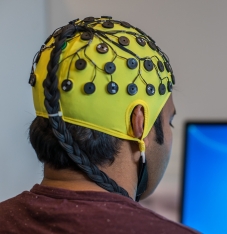 Objective
Objective
What consciousness is as well as the structure of the complete transcendental consciousness is known:
https://new-age-enlightenment.com/the-consciousness-of-the-new-age/
https://new-age-enlightenment.com/gurus/
The aim is to investigate, how the targeted creation of consciousness affects the earthly part of consciousness, especially the brain. The insights to be gained from this can provide important information about the functioning of the human brain.
Overview of the state of research to date
With this project, consciousness research is based on the personally experienced and in its structure recognized complete transcendental consciousness, so that it is sufficient to give only a brief overview of the state of research to date:
How can spirit arise from matter? To this end, among other things, animal experiments on the sensation of pain have been carried out, which ultimately remained open in interpretation.[1]
A central task of neuroscience is the search for the neuronal correlate of consciousness. That is, researchers want to find out, how our subjective experience emerges from brain processes. Some philosophers, on the other hand, doubt that the riddle of consciousness, with its subjective character of conscious experiences, can ever be solved by empirical scientific means, since these precisely dispense with the subjective perspective.[2]
The EEG records the sum of the tiny voltage fluctuations (of about 10 to 100 microvolts) on the surface of the skull, which the nerve cells of the cerebral cortex generate during their activity. For example, the level of consciousness of unresponsive patients can be measured with a “zap-and-zap” procedure. This involves first stimulating a specific area of the brain with an electromagnetic pulse and then recording the neuronal response by EEG. Consciousness is distinguished from unconsciousness by a higher complexity of the EEG signal.[3]
Brain areas responsible for wakefulness, sensory processing, attention, memory and emotions, for example, are supposed to interlock as partial functions in such a way that consciousness ultimately emerges from them. The synchronisation of nerve cell activity is said to be decisive for this. Through synchronisation, the neurons are supposed to selectively open a communication channel (comparable to a telephone line for long-distance calls) that enables a particularly efficient exchange of information. Neurons from different areas of the brain are said to organise themselves into complex networks, giving rise to consciousness.[4]
Further statements are:
People are always conscious and unconscious at the same time and both work together. This leads to a neuroscientific view that our minds are constantly making predictions about future events. Consciousness arises from prediction errors, i.e. surprise. When something does not go as expected, consciousness arises. In the process, our brain tries to avoid this state at all costs.[5]
Theoretically, we would have to distinguish between an experience on the one hand and our judgement or assumptions about that experience on the other. Only in rare cases do we succeed in doing so.[6]
Findings from embodiment research suggest that the whole body creates conscious experience.[7]
How useful are these approaches?
Since consciousness research, as this project, concerns the whole of transcendent consciousness, previous findings and methods need to be examined for their usefulness for this expanded scope.
Animal experiments on consciousness that inflict pain on animals or otherwise interfere with their natural lives must be stopped. When animals are tortured for their pain behaviour in experiments, only to deny them their consciousness despite clearly feeling pain, this only proves one thing, namely how low the level of consciousness of the researchers is. Consciousness does not arise from evolution, but creates evolution. This previous research approach is wrong.
Consciousness also does not emerge from brain processes, but creates brain processes. The approach of searching for consciousness from brain processes does not lead anywhere. Conversely, however, it is interesting to see which brain processes consciousness leads to. This is what consciousness research is investigating with this project.
Everyday consciousness can be distinguished from unconsciousness by EEG. Can the perception of complete transcendental consciousness also be distinguished from previous everyday consciousness by EEG? This is to be investigated.
The fact that only the physical effect on the nerve cells of the entire higher consciousness is measured by EEG, while the higher layers of awareness themselves remain unnoticed, speaks against a distinguishability. In favour of distinguishability, however, the higher layers of awareness may have changed brain activity right down to concrete brain use.
The approach of starting with the complex networks of the brain areas is helpful if one does not try to conclude from these to consciousness, but investigates the other way round. Which networks are generated by the higher level of consciousness? The actual networking takes place at the higher layers of awareness and is therefore not measurable with scientific equipment. However, how does the increased flow of energy into the earthly, the dissolved repressions also in the earthly part of consciousness and the delimitation in the earthly affect the brain?
The neuro-scientific prediction theory that consciousness arises from prediction errors as a surprise, does not explain the consciousness as such, but exactly matches the state of consciousness of the old age. The earthly part of consciousness behaves exactly as described. If it is identified with, as has been the case up to now, consciousness actually “arises” apparently only in the brief moments when the structure identification is interrupted by surprise. In fact, however, consciousness does not “arise” in these moments, but can only be temporarily perceived in these moments.
This identification with the earthly structures is also the reason, why people have so rarely been able to distinguish between an experience on the one hand and their judgement or assumptions about this experience on the other. In the meantime, however, there are people, who are able to identify themselves at will with all their different contents of consciousness, depending on their consciousness-creation, so that they can distinguish between their experience and the evaluation of their experience from the higher layers of awareness. Does this show up in the brain, and if so, how? These are the questions this project wants to explore.
It is also true for embodiment research that it is not the body that creates conscious experience, but that the body is merely the most energetically condensed and earthly part of consciousness in complete transcendental consciousness. So far, out of their complete transcendental consciousness, most people only perceive some contents of consciousness, such as the body, particularly clearly, others less clearly and most not consciously at all. Since the connection between the higher layers of awareness and the body is known through the consciousness creation of body healing with resulting recommendations on the health system of the new age, the body is not part of this research project.
What predictions result from near-death experiences?
The descriptions of near-death experiences, including the feelings of freedom from pain, with instead peace, joy and bliss, correspond to those of other states of consciousness, such as those triggered by meditation. Gamma, alpha and theta waves can be specifically activated through meditation.[8]
It was also found that in a certain intermediate phase after cardiac arrest and before brain death, some brain activity increases. The researchers did not observe a slow ebbing of neuronal brain activity, but quite the opposite, an extreme increase in cognitive processing; especially that of gamma brain waves and somewhat also of theta waves.[9]
These research findings so far suggest that the neurological effects of consciousness creation with total transcendental consciousness should also be measurable. Moreover, interesting and helpful results for the understanding of consciousness and the brain can be expected, because Musubi (the Universal Whole) leads us into this research project.
Project management: Ayleen Lyschamaya.
Current project status: The research project is still in the preparation phase of the concrete experimental design. Hints, ideas and cooperations are welcome.
Berlin, August, 2023, Ayleen Lyschamaya
[1] Subjective experience: Individual animal experiments are described in “Das schwierigste Problem” (“The most difficult problem”) by Susann Blackmore, in “Spektrum der Wissenschaft Kompakt”, “Das Rätsel Bewusstsein” of 2.12.2019.
[2] Neurophilosophy: “Des Rätsels Kern” (“The core of the mystery”) by Tobias Schlicht, in “Spektrum der Wissenschaft Kompakt”, “Das Rätsel Bewusstsein” of 2.12.2019.
[3] Brain activity: “Der Bewusstseinsdetektor” (“The consciousness detector”) by Christof Koch, in “Spektrum der Wissenschaft Kompakt”, “Das Rätsel Bewusstsein” of 2.12.2019.
[4] Cognitive research: “Das Netz des Bewusstseins“ (“The web of consciousness”) by Andreas K. Engel, in “Spektrum der Wissenschaft Kompakt”, “Das Rätsel Bewusstsein” of 2.12.2019.
[5] The unconscious: “Der Autopilot im Kopf“ (“The autopilot in the head”) by Steve Ayan, in “Spektrum der Wissenschaft Kompakt”, “Das Rätsel Bewusstsein” of 2.12.2019.
[6] Illusion of immediacy: “Es gibt kein bewusstes Denken“ (“There is no conscious thought”) by Peter Carruthers, in “Spektrum der Wissenschaft Kompakt”, “Das Rätsel Bewusstsein” of 2.12.2019.
[7] Embodiment thesis: “Nur eine Kopfgeburt?” (“Only a head birth?”) by Christian Wolf, in “Spektrum der Wissenschaft Kompakt”, “Das Rätsel Bewusstsein” of 2.12.2019.
[8] „Was im Gehirn wirklich passiert, wenn du meditierst“ (“What really happens in the brain when you meditate”) by Axel Kühnle, guest post in the flowgrade blog of 29.9.2020.
[9] Wikipedia on near-death experiences, as of 6/2021.

![New Age of the Am-Ziel-Erleuchtung© [Final-Enlightenment(AL)]](https://new-age-enlightenment.com/wp-content/uploads/2018/03/new-age-enlightenment-spiritual-master-ayleen.jpg)